
Nepenthes sibuyanensis is a tropical pitcher plant endemic to Sibuyan Island in the Philippines, after which it is named.

Nepenthes truncata is a tropical pitcher plant endemic to the Philippines. It is known from the islands of Dinagat, Leyte, and Mindanao. The species grows at an elevation of 0–1500 m above sea level. Nepenthes truncata is characterised by its heart-shaped (truncate) leaves and very large pitchers, which can reach up to 40 cm in height.

Nepenthes mirabilis, or the common swamp pitcher-plant and tropical pitcher plant, is a carnivorous plant species. By far the most widespread of all Nepenthes, its range covers continental Southeast Asia and all major islands of the Malay Archipelago, stretching from China in the north to Australia in the south. The species exhibits great variability throughout its range. One of the more notable varieties, N. mirabilis var. echinostoma, is endemic to Brunei and Sarawak and possesses an extremely wide peristome.

Nepenthes alata is a tropical pitcher plant endemic to the Philippines. Like all pitcher plants, it is carnivorous and uses its nectar to attract insects that drown in the pitcher and are digested by the plant. It is highly polymorphic, and its taxonomy continues to be subject to revisions.
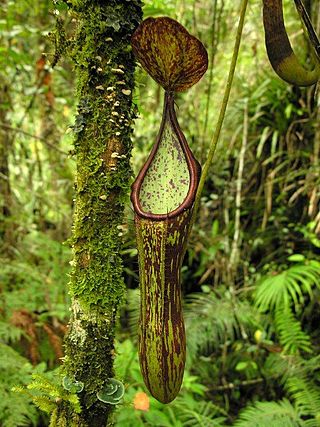
Nepenthes copelandii is a species of pitcher plant native to the island of Mindanao in the Philippines. Originally known from Mount Apo near Davao City and Mount Pasian near Bislig, it has since been discovered on a number of peaks throughout Mindanao. It may also be present on the nearby island of Camiguin. The species has a wide altitudinal distribution of 1100–2400 m above sea level. Nepenthes copelandii has no known natural hybrids. No forms or varieties have been described.
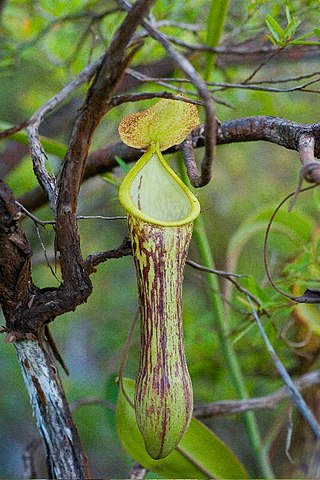
Nepenthes mindanaoensis is a tropical pitcher plant native to the Philippine islands of Mindanao and Dinagat.

Nepenthes philippinensis is a tropical pitcher plant endemic to the Philippines. It is known from Palawan and the neighbouring Calamian Islands and Linapacan, where it grows at 0–600 metres (2,000 ft) above sea level.
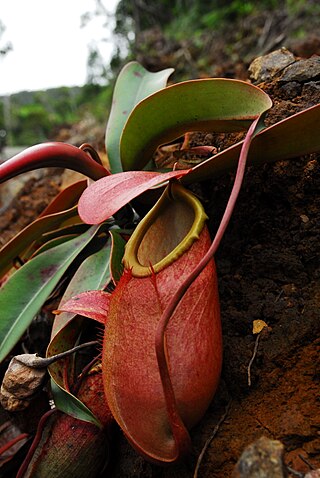
Nepenthes merrilliana is a tropical pitcher plant endemic to the Philippines. It produces some of the largest pitchers in the genus, rivalling those of N. rajah.

Nepenthes eustachya is a tropical pitcher plant endemic to Sumatra, where it grows from sea level to an elevation of 1600 m. The specific epithet eustachya, formed from the Greek words eu (true) and stachys (spike), refers to the racemose structure of the inflorescence.

Nepenthes petiolata is a highland Nepenthes pitcher plant species endemic to Mindanao island in the Philippines, where it grows at an elevation of 1,450–1,900 metres (4,800–6,200 ft) above sea level.
Nepenthes × truncalata is a natural hybrid involving N. alata and N. truncata. Like its two parent species, it is endemic to the Philippines, but limited in distribution by the natural range of N. truncata on Mindanao.

Nepenthes × ventrata is a natural hybrid involving N. alata and N. ventricosa. Like its two parent species, it is endemic to the Philippines. The name was originally published in the Carnivorous Plant Newsletter in 1979.
Nepenthes × tsangoya is a tropical pitcher plant. It reportedly represents the complex natural hybrid × N. mirabilis.

Nepenthes of Sumatra and Peninsular Malaysia is a monograph by Charles Clarke on the tropical pitcher plants of Sumatra, Peninsular Malaysia, and their minor surrounding islands. It was published in 2001 by Natural History Publications (Borneo). Clarke described it as "intermediate between an ecological monograph and a taxonomic one".
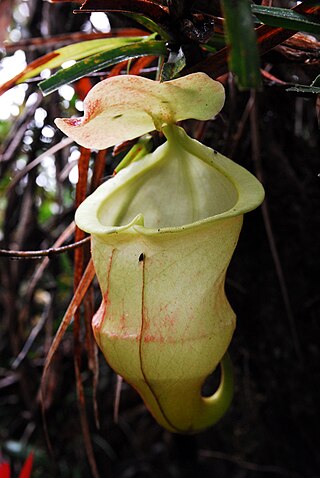
Nepenthes hamiguitanensis is a tropical pitcher plant endemic to a single peak on the Philippine island of Mindanao, where it grows at elevations of 1200–1600 m above sea level. Once thought to be a natural hybrid between N. micramphora and N. peltata, this plant is now considered a species of possible hybridogenic origin. It produces squat upper pitchers that vary greatly in pigmentation, from red speckled to yellow throughout.
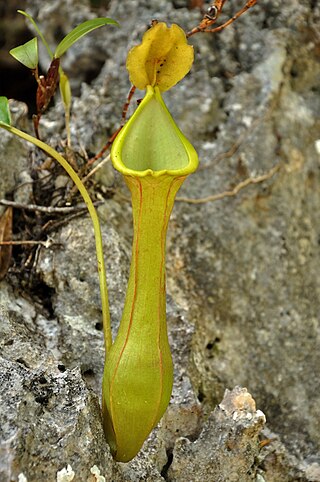
Nepenthes viridis is a tropical pitcher plant endemic to the Philippines. It is known only from coastal areas at low altitude and has been recorded from Dinagat, Samar, and a number of surrounding islets. It is closely allied to the N. alata group of species.

Nepenthes extincta is a tropical pitcher plant native to the Philippines. It is known only from Surigao del Sur, Mindanao, where it has been recorded at c. 400 metres (1,300 ft) altitude.














